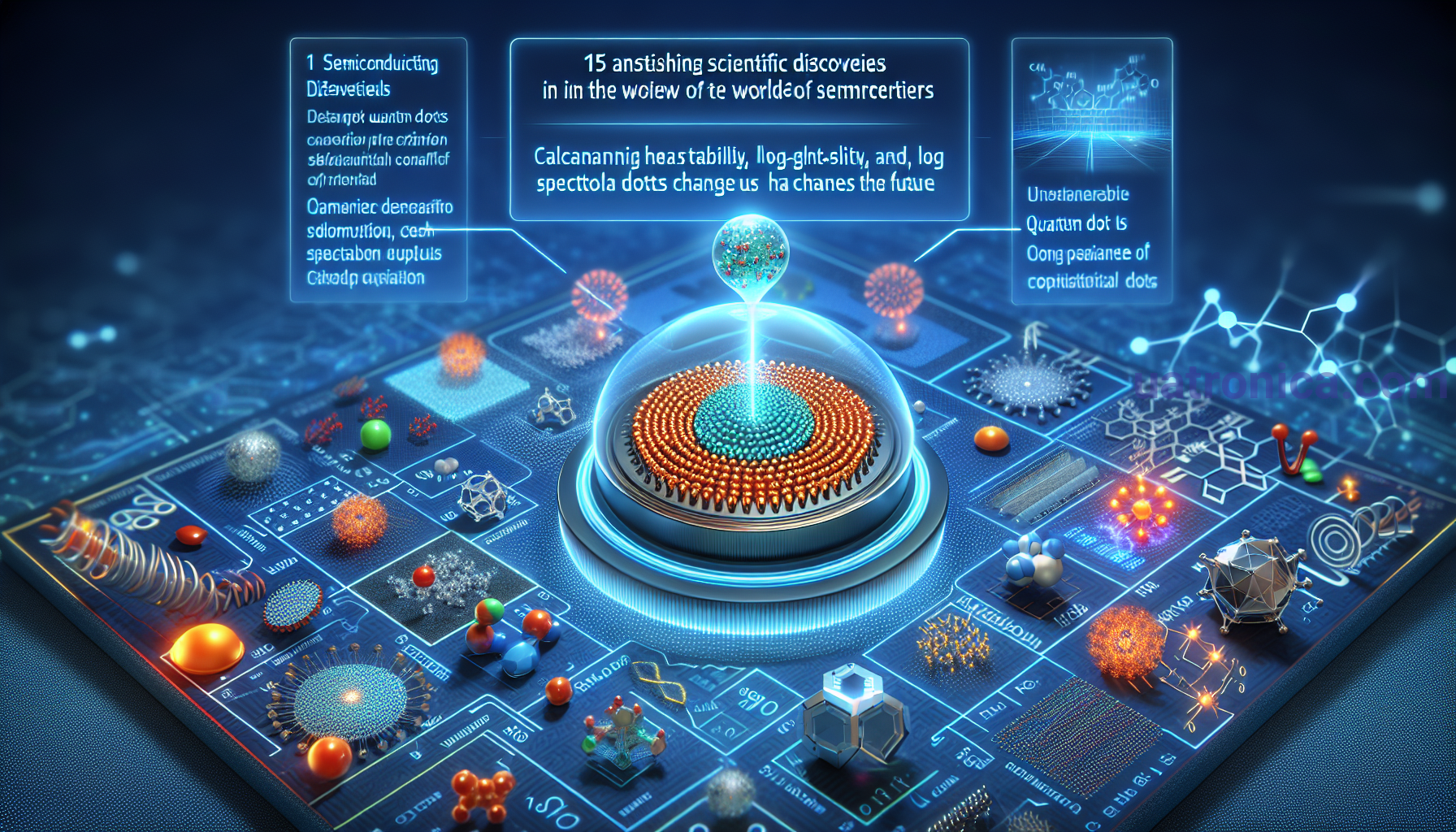A review of 15 unusual scientific discoveries in the world of semiconductors: exciting innovations that are sure to change the future
Semiconductors are a key component of modern electronics. They provide the basis for the development of hundreds of electronic devices, from smartphones and computers to highly efficient solar cells and high-speed energy storage devices. Recent decades have been marked by remarkable development in the field of semiconductor materials and technologies. The more scientists explore this direction, the more opportunities they find for advanced technologies and innovations. This review takes a detailed look at 15 extraordinary scientific discoveries in the world of semiconductors that are sure to change the future.
1. Graphene: the thinnest semiconductor
Graphene is a uniform layer of carbon atoms that forms a hexagonal network. This material is considered the thinnest semiconductor and has many unique properties. Graphene is one of the strongest materials, it has excellent conductivity, high thermal conductivity and optical transparency. In addition, graphene is the most flexible material in the world. Its potential for applications in electronics, photonics, energy, and medicine is limitless.
One of the most important positions of graphene in electronics is the development of transistors based on it. Graphene transistors have the potential to underpin a new generation of electronics because they can operate at higher speeds while using less energy than traditional silicon transistors. However, several technological challenges need to be addressed before graphene can be used in large-scale devices.
2. Quantum dots: new dimensions for electronics
Quantum dots are very small regions of semiconductors that range in size from 2 to 10 nm. They have unique properties that make them powerful tools for the development of new electronic devices. Due to their size, quantum dots can change their physical properties, such as color spectrum, conductivity and optical activity. This opens up wide possibilities for applications of quantum dots in high-quality televisions, LEDs, solar cells and biomedical devices.
One of the significant achievements in the field of quantum dots is the development of quantum dot displays. These displays, used in smartphones and televisions, provide the highest image quality thanks to a wider color spectrum, high contrast and deeper blacks. In addition, quantum dots allow the creation of flexible displays, which opens up new perspectives for the development of complex display formats.
3. Chalcogenide perovskites: reflectors of the future
Chalcogenide perovskites are a class of semiconductor materials that have incredible potential in LED and photonic devices. For example, a perovskite LED can have significantly higher efficiency and longevity than a traditional LED based on quantum dots or organic materials. In addition, perovskite LEDs can be grown on a variety of substrates, including flexible and transparent materials, enabling their use in a variety of devices and devices with limited space. The unusual properties of perovskites also make them potential candidates for use in solar cells and other energy devices.
4. Silicon photonic waveguides: light energy at the service of data processing
Silicon photonic waveguides are becoming increasingly popular in the data processing world. These devices use the properties of light instead of electrical signals to transmit and process information. Silicon photonic waveguides, which consist in the directed movement of light waves based on silicon and other semiconductor materials, have a low level of distortion and allow information to be transmitted at high speeds over long distances.
One of the most important advances in this field is the development of optimized silicon photonic chips that can be used in computing devices and data centers. This enables manufacturers to increase data rates, reduce power consumption and reduce the size of devices. Innovations in the field of photonic waveguides open new horizons for the development of high-speed, powerful and energy-efficient data processing devices.
5. Thin-film transistors: high efficiency at the molecular level
Thin film transistors are one of the most significant discoveries in the world of semiconductors. These transistors use molecular ions to control the electronic current, which gives a much higher efficiency compared to conventional silicon transistors. Thin film transistors have the potential to develop a new generation of electronics that will operate at higher speeds and with lower power consumption.
Prototypes of thin-film transistors are already distinguished by their amazing characteristics. For example, one study showed that thin-film transistors can switch at a speed of about 109 Hz, which is significantly faster than conventional silicon transistors. In addition, thin-film transistors make it possible to grow high-quality semiconductor structures on substrates of liquid crystal, graphene, and other materials. This paves the way for the development of flexible electronic devices and electronics at the household level.

6. Solar batteries of the third generation: saving energy directly from the sun
Solar energy is one of the cleanest and freest sources of energy, but requires efficient devices to convert it into electrical energy. Third-generation solar cells are considered a promising solution because they can significantly improve the conversion of solar energy into electricity.
The development of third-generation solar cells is based on the use of new semiconductors, such as perovskites, thin-film transistors, and photonic waveguides. These materials open new possibilities for creating solar cells with high efficiency, low production costs and new formats. One of the most promising advances in this field is the development of perovskite solar cells, which have powerful conversion efficiencies and can be grown on a wide range of materials, including plastics and textiles.
7. Quantum computing technology: the next era of data processing
Quantum computers are a new form of computing technology that uses quantum bits instead of classical bits to store and process information. Quantum bits, or qubits, can be in a state of simultaneity, which enables quantum computers to perform many calculations simultaneously and allows information to be stored in complex interference states.
This technology opens wide prospects in the world of computer technology. For example, quantum computers can significantly speed up the calculation of cryptographic keys, optimize the processes of complex calculations and solve problems that classical computers cannot solve. Major companies such as IBM, Google, and Microsoft are already investing in the development of quantum computers, and this technology is expected to become a reality in the near future.
8. Heterostructures based on semiconductors: new materials for the electronics of the future
Heterostructures based on semiconductors are structures that consist of different layers of semiconductors with different properties. These structures, which can be composed of a variety of materials, are used to create new electronic devices with improved performance.
One of the best-known examples of heterostructures is Gallium Aluminum Arsenide/Gallium Arsenide heterostructures, which are used in UV-to-IR light-resistant devices such as lasers, photodiodes, and optical fibers. In addition, heterostructures with quantum wells are widely used in LEDs and lasers with an arbitrary color spectrum and high image quality.
9. Quantum dotaper integrated circuits: technology for the quantum future
Quantum dotaper integrated circuits are a new class of semiconductor devices used in quantum computers to store, transmit, and process qubits. These integrated circuits are based on the use of quantum dots, which can store quantum information on dotapers instead of conventional transistors.
Quantum dotaper integrated circuits open many possibilities for the development of miniature and energy-efficient quantum computers. They are used to create stable quantum bits, reduce the number of distortions and significantly reduce power consumption. These integrated circuits will help usher in an era where quantum computing will become a reality.
10. Phantom Small Wheels: The smallest technology wearables
Phantom small coils are dome-shaped structures that have a diameter of only 5-10 μm, but contain entire microcircuits. These slides are used to develop technology carriers that can be applied to surfaces, such as smartphones, hands, and various devices.
One of the main applications of phantom small eyes is medical diagnostics. They can be used to provide doctors with real-time information about the patient and their health indicators, such as heart rate, blood oxygen levels, and more. In addition, the phantom small wheels could be used to create intelligent devices that can analyze and respond to information.
11. Calcium-based quantum dots: a new breakthrough in LEDs

Calcium-based quantum dots (CaQDs) are a new class of semiconductor materials used in LEDs. They have a long thermal stability, a range of spectral characteristics and a low price. Calcium-based quantum dots open a new way to create highly efficient, long-lasting and affordable LEDs with a wide range of colors.
One of the important examples of the use of CaQD is the development of LEDs with a minimum emission of blue light (blue light-emitting diode), which helps prevent eye damage and reduces color distortion. In addition, CaQD can be used to design optical devices with a wide spectrum of colors, such as UV, visible, and infrared light guides.
12. Energy-efficient solar power systems: for stable power supply
Energy-efficient solar power systems use new technologies to improve the efficiency of collecting and storing solar energy. These systems use semiconductor materials such as quantum dots and perovskites to improve the conversion of solar energy into electricity.
For example, one of the most promising developments in this field is the development of solar cells that can operate at high temperatures, ensuring stable performance even in extreme conditions. In addition, energy-efficient solar power systems use innovative energy storage technologies, such as solar batteries, to store excess energy and use it in the dark or in adverse weather conditions.
13. Silicon quantum computer: dream come true
A silicon quantum computer is a new type of quantum computer that uses silicon chips and transistors to store and process qubits. This technology opens up new opportunities for creating efficient and affordable quantum computers that can be used in various fields.
One of the important achievements in this field is the development of silicon qubits, which have a long storage time of quantum information and can be easily integrated with classical computer parts, such as memory chips and processors. Silicon quantum computers open new perspectives for the development of fast and energy-efficient computing systems that will revolutionize the world of data processing.
14. Ferroelectric materials: energy-saving components of the future
Ferroelectric materials are a special class of semiconductor materials that have memory properties and can store a charge of electrical energy. These materials are used in a variety of electronic devices, including chips, batteries, and capacitors.
For example, ferroelectric materials can be used to create energy-saving capacitors that store electrical energy longer and more safely than traditional capacitors. In addition, ferroelectric materials can be used to create components such as ferroelectric memory, which is used in modern smartphones and computers for data storage.
15. Multiferroics: new functional possibilities for materials
Multiferroics are semiconductor materials that exhibit ferromagnetic and ferroelectric properties at the same time. These materials have the potential to develop new functional devices that can combine the properties of magnetic horizontal, electronic and photonic devices.
One of the first devices based on multiferroics are spin transistors, which use the spin of electrons to transmit and process information. These transistors can have higher speed and lower power consumption compared to conventional silicon transistors. In addition, multiferroics allow the development of nanomagnetic devices that have great potential for information storage and data processing.
Conclusion
Semiconductors are key components of electronics, and the world of semiconductors moves forward with new innovations and discoveries. This review presents 15 unusual scientific discoveries in the world of semiconductors that will definitely change the future. From graphene to quantum dots and multiferroics, these innovations are opening up a host of new possibilities in a variety of fields, including electronics, energy and computing. The intersections of research into innovative materials, efficient devices and new technologies open up new horizons for our future, and we can expect more fantastic discoveries in the world of semiconductors.
You can learn more about the latest advances in semiconductors and electronics in the article that is available here. Also, more interesting information about the technological discoveries that shape the future of electronics can be found in the article that is available here.










